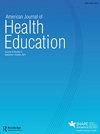高中学生和照顾者对食物获取和遵守家庭和社区营养指南的看法的定性分析
IF 0.8
Q4 PUBLIC, ENVIRONMENTAL & OCCUPATIONAL HEALTH
引用次数: 0
摘要
【摘要】背景:联邦营养教育计划(“我的餐盘”)旨在促进家庭健康饮食行为;然而,对于少数族裔学生和照顾者如何看待遵守“我的餐盘”指南,或如何看待与指南一致饮食的重要性,我们知之甚少。研究目的包括:1)确定学生和照顾者如何看待他们的饮食摄入,因为它与我的餐盘在家庭和社区环境中有关;2)评估坚持我的餐盘指南的动机。方法对47名高中生进行面对面焦点小组调查,对24名照顾者进行访谈,采用定性主题分析方法进行编码。结果在家用餐与在餐馆用餐在食物组分量上存在差异。护理人员在购买特定食品组时强调食品成本是主要因素。按照我的餐盘进食的原因包括:1)健康状况/疾病预防;2)体重状况;3)营养平衡;4)增加能量。营养活动可能会受益于不把食物分类放在狭窄的盒子里的图像。需要开展工作来解决影响指南依从性的食物可及性的系统、环境和个人因素。健康教育实践结果的转化可以支持地方和联邦资助倡议,解决健康饮食的障碍,并提供有针对性的教育工具,而不是我的盘子。披露声明作者未报告潜在的利益冲突。本研究部分由DePaul大学研究委员会的夏季研究补助金,DePaul大学科学与健康学院的教师夏季研究补助金和国家乳制品委员会资助[#501384]。我们也要感谢我们的合作学校和参与的学生和照顾者。本文章由计算机程序翻译,如有差异,请以英文原文为准。
A Qualitative Analysis of High School Student and Caregiver Perceptions of Food Access and Adherence to Nutrition Guidelines Across Home and Community Settings
ABSTRACTBackground Federal nutrition education initiatives (“MyPlate”) intend to facilitate healthful eating behaviors in families; however, little is known about how minoritized students and caregivers perceive adherence to MyPlate guidelines or perceptions of importance of eating in alignment with guidelines.Purpose Study aims included: 1) determine how students and caregivers perceive their dietary intake as it relates to MyPlate in both home and community environments and 2) assess motivations to adhere to MyPlate guidelines.Methods In-person focus groups with 47 high school students and 24 caregiver interviews were conducted and coded using qualitative thematic analysis.Results Meals at home differed from restaurants regarding food group portions. Caregivers highlighted food cost as a major factor when purchasing for specific food groups. Reasons for eating in accordance with MyPlate included: 1) health status/disease prevention, 2) weight status, 3) nutritional balance, 4) increased energy.Discussion Nutrition campaigns may benefit from images that do not put food categories into narrow boxes. Work is needed to address systemic, environmental, and individual factors in food accessibility across settings that affect guideline adherence.Translation to Health Education Practice Findings can support local and federal funding initiatives addressing barriers to healthful eating and provide targeted educational tools beyond MyPlate. Disclosure statementNo potential conflict of interest was reported by the author(s).Additional informationFundingThis study was partially funded by DePaul’s University Research Council’s Summer Research Grant, DePaul University’s College of Science and Health’s Faculty Summer Research Grant, and the National Dairy Council [#501384]. We’d like to also thank our partner schools and participating students and caregivers.
求助全文
通过发布文献求助,成功后即可免费获取论文全文。
去求助
来源期刊

American Journal of Health Education
PUBLIC, ENVIRONMENTAL & OCCUPATIONAL HEALTH-
CiteScore
1.70
自引率
10.00%
发文量
36
期刊介绍:
AJHE is sponsored by the American Association for Health Education of the American Alliance for Health, Physical Education, Recreation and Dance. The mission of the American Association for Health Education(AAHE) is to advance the profession by serving health educators and others who strive to promote the health of all people through education and other systematic strategies.AAHE addresses the following priorities •Develop and promulgate standards, resources and services regarding health education to professionals and non-professionals •Foster the development of national research priorities in health education and promotion. Provide mechanisms for the translation and interaction between theory, research and practice.
 求助内容:
求助内容: 应助结果提醒方式:
应助结果提醒方式:


